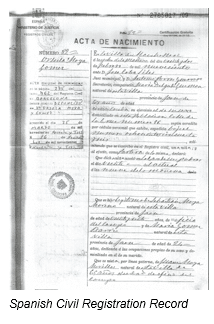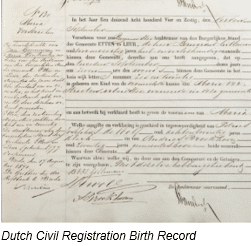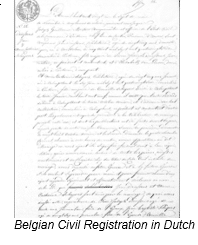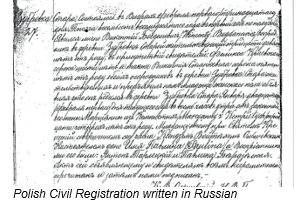Napoleonic Civil Registration Records, Part 3
 25
25Jun
Part 1 of this blogpost covered the record types for Napoleonic-era civil registration records. Part 2 highlighted records from the regions of France, Italy, and Germany. This final section will discuss civil registration records in the Netherlands, Belgium, Poland, Spain, and Portugal.
Civil Registration
Netherlands
Napoleon annexed the Netherlands in 1806, proclaiming his brother Louis  Bonaparte king of Holland on 5 July 1806. Civil registration was implemented by French decree on 1 March 1811 in the Netherlands, requiring that civil authorities in each municipality record the births (geboorten), marriages (huwelijken), and deaths (overlijden). Even after Napoleonic occupation ended in 1813, the Netherlands continued to keep the detailed civil registration records introduced by the French, and have continued to do so until the present.
Bonaparte king of Holland on 5 July 1806. Civil registration was implemented by French decree on 1 March 1811 in the Netherlands, requiring that civil authorities in each municipality record the births (geboorten), marriages (huwelijken), and deaths (overlijden). Even after Napoleonic occupation ended in 1813, the Netherlands continued to keep the detailed civil registration records introduced by the French, and have continued to do so until the present.
In order to find civil registration records for your ancestor, you must identify which province your ancestor lived in. This can be done by using a gazetteer or by searching for your locality on the FamilySearch Wiki. Virtually all Dutch civil registration records have been digitized and indexed, thus proving to be an irreplaceable resource in Dutch genealogical research.
Websites and data sets that are useful for Dutch civil registration include:
- WieWasWie, the official government site for Dutch genealogical research. This site has almost all marriages online, along with many deaths, and some births. Images for the original records are included for most records.
- OpenArch is a searchable website with Dutch civil registration records.
- Ancestry, Netherlands, Civil Marriage Index, 1795-1950
- Ancestry, Netherlands, Birth Index, 1784-1917
- Ancestry, Netherlands, Burial Index, 1540-1899
Belgium
Belgium was conquered by Napoleon in 1795. The French introduced a system of civil registration upon annexation. Upon Napoleon’s defeat in 1815, Belgium merged with the Netherlands, creating the kingdom of the Netherlands. Both the Netherlands and Belgium continued with Napoleonic civil registration. In 1830, Belgium became independent from the Netherlands, though they continued with the Napoleonic style of civil registration, and have continued to do so ever since. Access to civil registrations is unrestricted to the public for births that occurred over 100 years ago, marriages that occurred over 75 years ago, and deaths that occurred over 50 years ago.
Civil registration records were recorded in either French, Dutch, or German,  depending on the language locally spoken. Online collections that are useful for finding Belgian civil registration records include:
depending on the language locally spoken. Online collections that are useful for finding Belgian civil registration records include:
- FamilySearch, Belgium Births and Baptisms, 1560-1890
- FamilySearch, Belgium Marriages, 1563-1900
- FamilySearch, Belgium Deaths and Burials, 1564-1900
- Record sets also exist on the province level for Belgian civil registration records on FamilySearch. This can be accessed by searching for your locality on the FamilySearch Wiki or the FamilySearch Catalog.
Poland
In 1807, Napoleon created a new Polish state, fashioned out of territories previously held by Prussia and Austria, called the Duchy of Warsaw. Civil registration of births, marriages, and deaths was implemented under French rule in the Duchy of Warsaw on 1 May 1808. Upon Napoleon’s defeat in  1815, the Russian government assumed control of the area. The Russian government maintained civil registers. In 1918, Poland became an independent republic, and they too continued with recording civil registration. Thus, civil registers in the Napoleonic format are found in all of Russian Poland, in Kraków, and in parts of the Prussian province of Posen, all of which were formerly part of the Grand Duchy of Warsaw. At the beginning of civil registration in 1808, records were kept in Polish. A decree in April 1868 required that they be kept in Russian. In 1918, they were again kept in Polish.
1815, the Russian government assumed control of the area. The Russian government maintained civil registers. In 1918, Poland became an independent republic, and they too continued with recording civil registration. Thus, civil registers in the Napoleonic format are found in all of Russian Poland, in Kraków, and in parts of the Prussian province of Posen, all of which were formerly part of the Grand Duchy of Warsaw. At the beginning of civil registration in 1808, records were kept in Polish. A decree in April 1868 required that they be kept in Russian. In 1918, they were again kept in Polish.
Civil registration records were kept at the Urząd Stanu Cywilnego, or the local civil registration office, in each town or city. To find civil registration records for your ancestor, you must first identify the town or village that they lived in. Using Mapa Szukacz, you can find information regarding the civil registration district places of your ancestor. Once you’ve identified where your ancestor was living, you can use that information to locate their civil registration information, as they were recorded on the town level.
The Family History Library has microfilmed the records of many town in Poland. These can be accessed by searching for the town or civil registration municipality your ancestor lived in on the FamilySearch catalog. Online resources that can be helpful in location Polish civil registration records include:
- Szukaj w Archiwach (The Polish State Archives)
- The PRADZIAD Database, a database that includes information on parish and civil registration registers from the Polish State Archives
Spain and Portugal
 Napoleon’s forces first invaded Spain and Portugal in 1807, and by 1808 Napoleonic France occupied the territory. Unlike other European nations annexed by France, Spain and Portugal continued to resist French rule. Battles between French, Spanish, Portuguese and British armies beset the area until 1814, when the French were defeated. Because the French were so focused on fighting in the area, they never implemented civil registration.
Napoleon’s forces first invaded Spain and Portugal in 1807, and by 1808 Napoleonic France occupied the territory. Unlike other European nations annexed by France, Spain and Portugal continued to resist French rule. Battles between French, Spanish, Portuguese and British armies beset the area until 1814, when the French were defeated. Because the French were so focused on fighting in the area, they never implemented civil registration.
Civil registration was not introduced to Spain until 1871, when it was required upon royal decree, though some municipalities may have civil registration records beginning as early as 1837. Though Spanish civil registration didn’t start until decades after Napoleon’s occupation of Spain, the forms adopted in 1871 contain virtually identical information to information found in Napoleonic civil registers. Civil registration records vary in accessibility by region. Civil registration records are stored by the municipality level, so to find your ancestor in civil registration, you must first identify which Spanish municipality that they lived in. This can be determined by using a gazetteer. Next, you should search for that municipality on the FamilySearch catalog and the FamilySearch Wiki to determine record availability. Spain does have a national index or central repository for civil registration online (Ministerio de Justicia) for copies of certificates. In order to make a request, you must know the name of the ancestor, date when the birth, marriage, or death occurred, and where the event occurred. Ordering Spanish civil registration records online require a small fee, and it may take weeks for your request to be processed.
Civil registration in Portugal preceded that of Spain by forty years: the Portuguese passed legislation requiring that births, marriages, and deaths of all citizens be recorded in 1832. As with Spain, civil registration records were stored at the municipal office. Thus, it is crucial that you find the municipality place of your ancestor, which can be found using a gazetteer or the FamilySearch wiki and catalog pages. Though not all Portuguese civil registration records can be found online, some are available on the following sites:
- FamilySearch: access these records via the FamilySearch catalog for the municipality of interest
- pt: As with FamilySearch, these are organized on the municipality level
- The District Archives: A Portuguese archive site, with some digitized civil registration records.
Though this era of Napoleonic civil registration grew out of Napoleon’s conquests, it has been an invaluable resource for family historians to discover and reconstruction their heritage. The expert genealogists at Price Genealogy can help you recover family memories of earlier generations.
By Kaitlyn
Have you done any civil registration genealogy work? Let us know in a comment below!
